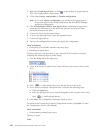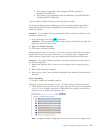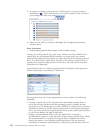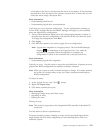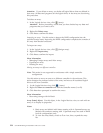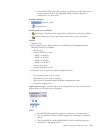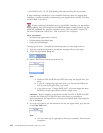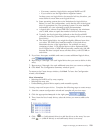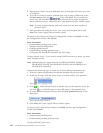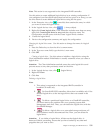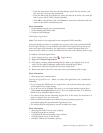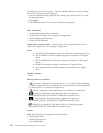
Understanding logical-drive synchronization: The purpose of synchronizing logical
drives is to compute and write the parity data on the selected drives.
Synchronizing a logical drive verifies that the data redundancy for the logical drive
is correct.
Note: You can determine if your controller firmware supports
auto-synchronization and data scrubbing by viewing the controller
properties. The properties pane reports if these features are enabled or
disabled.
Using auto-synchronization
If the logical drive is attached to a controller that supports auto-synchronization,
the ServeRAID Manager automatically synchronizes all new RAID level-5, 5E, 5EE,
and 50 logical drives. These logical drives must be synchronized before storing
data. Auto-synchronization ensures that the parity data is accurately computed.
Accurate parity is critical for updating the parity when you begin to store data.
For the ServeRAID-8i, ServeRAID-8k/8k-l, and ServeRAID-7t
controllers, the ServeRAID Manager also supports auto-synchronization for RAID
level-1 and 10 logical drives. During auto-synchronization, data from the primary
drive is automatically copied to the mirror drive.
Depending on the controller, the ServeRAID Manager displays either a progress
indicator in the status bar or a
(in animation) in the Logical devices view,
indicating that auto-synchronization is in progress. You can perform some actions
on the controller during an auto-synchronization, such as deleting a logical drive;
however, you cannot perform a logical drive migration. Also, you can turn off the
server during an auto-synchronization and, when you turn on the server, the
firmware will continue the auto-synchronization where it left off.
Using manual synchronization
When you create a logical drive that is attached to a controller that does not
support auto-synchronization, you will receive a warning event in the event viewer
stating that you must manually synchronize the logical drive before storing data.
Use ″Synchronize logical drives″ to manually synchronize the logical drive. You
must synchronize new RAID level-5 logical drives after you create them.
Manual synchronization can be a lengthy operation. You can synchronize the
logical drive immediately or schedule it for a later date and time. You can also
schedule the synchronization as a recurring task. A recurring synchronization task
starts at the initial start time, then runs periodically according to the given interval:
the same time each day, each week, or each month. Do not turn off the server until
the manual synchronization is complete.
For ServeRAID SCSI controllers, you cannot perform any other actions on
the controller until the manual synchronization is completed.
Using manual synchronization for data scrubbing
Data scrubbing is an automatic background synchronization process. Data
scrubbing keeps data ″fresh″ by doing the following:
v (For RAID level-5, 5E, 5EE, or 50) Reading data and rewriting the data parity.
Chapter 4. Managing ServeRAID devices 127




